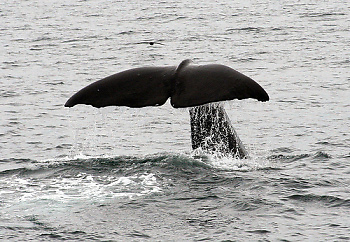During our final week of research on how to make Texel self-sufficient in 2065 we actually went to Texel to do some on-site research and make one shared plan as a group. Some special news came to us during our stay: six male sperm whales, who probably had accidentally chosen the wrong way back to the south, had washed up on the shore of Texels’ beach. When I did some more research on these huge sea creatures I found out that they have a positive influence on our environment as well.
Sperm whales live in groups and in the spring, the males head to the north. In the late autumn and winter they go back to the south. When the males come back, they have two choices; through the North Atlantic where they have enough space to swim or through the much more narrow North Sea. This second route could get them into problems since sperm whales orient themselves with sonar, the gaps between the Waddenislands prevent the echo to go back.
A recent study from a PhD student from Flinders University in Australia shows that in the Southern Ocean the combination of sperm whale manure and Phytoplankton can be very beneficial to the environment. The study finds that manure from a sperm whale is rich in iron. The sperm whales defecate on the Phytoplankton, which on their turn uses this iron to grow and trap carbon. The carbon is not released until the plankton plankton dies. Then the carbon sinks down deep in the ocean. According to the study, the sperm whales from the Southern Ocean offset approximately 400,000 tons of carbon from the atmosphere each year. On the big scale; it is very important that we have phytoplankton in general, since it accounts for half of all photosynthetic activity on earth.
Not only alive they help us towards a more sustainable environment: next to fact that it is very sad for those animals to wash up and die, they do provide us with essential research material. The dead animals are for example tested by the whale team from research institute Naturalis and the Dutch Wildlife Health Centre on their general state of being, possible hearing problems and their cause of dead. The results of the different tests and research that is being done on these animals could possibly also lead to the prevention of more animals choosing the wrong route and washing up.
However, not everything about the life and dead of these six animals is beneficial for the environment: during our time on the island, the sperm whales were already being cut and sawn into smaller pieces. These pieces were brought to the harbour of Texel with (polluting) trucks and later on shipped to Harlingen from where they were being transported to a company in Noord-Brabant, all the way on the other side of the Netherlands.
Concluding one could say that the washing up and dying of these six sperm whales is indeed a sad event, however, it is part of nature. Although they are very beneficial for our environment during their life, them washing up provides us with a lot of essential material for research and prevention of more animals dying (unnecessary) in the future. By doing this extra research on sperm whales, for now, my only question is: couldn’t we have handled the transport of these animals in a more sustainable way?
Sources:
http://www.nu.nl/binnenland/4198847/potvissen-van-strand-texel-gehaald.html
http://www.nu.nl/weekend/4197896/potvissen-stranden-omdat-ze-verkeerde-afslag-nemen.html
http://www.nu.nl/binnenland/4196678/vijf-potvissen-aangespoeld-strand-texel.html
http://www.nu.nl/binnenland/4197288/naturalis-onderzoekt-dode-potvissen.html
http://www.nature.com/scitable/blog/saltwater-science/why_whaling_why_save_the
